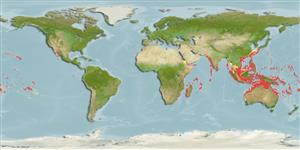Common names from other countries
Classification / Names / Names
Populärnamn | synonymer | Catalog of Fishes (gen., sp.) | ITIS | CoL | WoRMS
Environment: milieu / climate zone / depth range / distribution range
Ekologi
Revassocierade; djupintervall 0 - 125 m (Ref. 105618). Tropical; 32°N - 31°S, 30°E - 108°W
Indo-Pacific. Tropical and subtropical.
Length at first maturity / Size / Vikt / Age
Maturity: Lm ? range ? - ? cm Max length : 14.0 cm CL hane/ej könsbestämd; (Ref. 128968)
Adults are found under rocks and burried in sandy mud (Ref. 128968). The pentagon-shaped carapace and appendages are covered with spines. Pincers are unequal in size, length of which are double the size of the carapace (Ref. 128968). May contain toxins that are undectectable in tests (Ref. 107779), and thus, may not be safe to eat (Ref. 128968). Prefers sandy substrates (Ref. 2899). Subtidal (Ref. 106854). Large chela is used to crush snails and molluscan shells of hermit crabs. Reported to be mildly toxic to toxic. Toxicity of its flesh may be a result of accumulation of toxins from its diet (Ref. 102986).
Life cycle and mating behavior
Könsmognad | Reproduktion | Lek | Ägg | Fecundity | Larver
Members of the order Decapoda are mostly gonochoric. Mating behavior: Precopulatory courtship ritual is common (through olfactory and tactile cues); usually indirect sperm transfer.
Poupin, J. 2050. (Ref. 2891)
IUCN Red List Status (Ref. 130435)
CITES status (Ref. 108899)
Not Evaluated
Not Evaluated
Threat to humans
Poisonous to eat (Ref. 128968)
Human uses
Fiskeri: kommersiell
| FishSource | Sea Around Us
Verktyg
Ytterligare information
Age/SizeTillväxtLength-weightLength-lengthMorfologiLarverAbundans
Internet-källor
Estimates based on models
Preferred temperature
(Ref.
115969): 24.5 - 29, mean 27.9 (based on 1562 cells).
Price category
Unknown.
